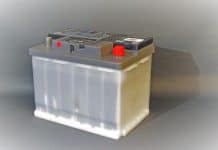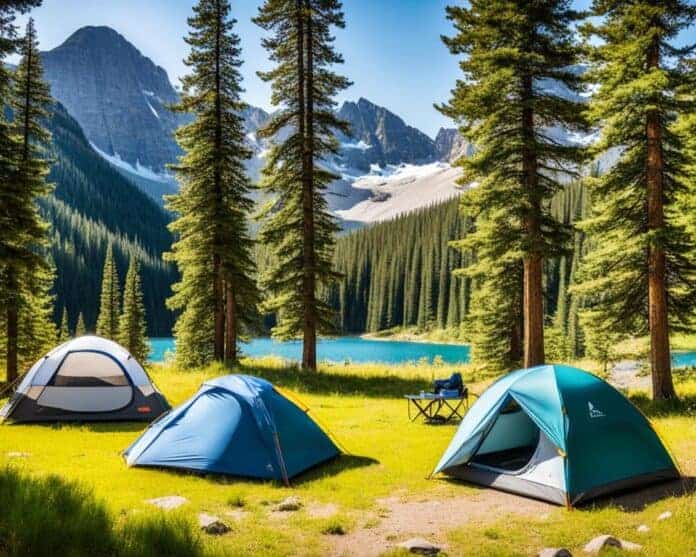Unlock the full potential of your outdoor adventure with the right camping gear – a choice that begins with securing a reliable shelter. Embarking on a journey into the wild is as exciting as it is unpredictable, and a quality camping tent is your first line of defense. It not only provides a respite from the day’s exhilarations but also ensures your safety and comfort throughout the nighttime. As you gear up for your next camping experience, remember that the tent you choose can either amplify your enjoyment or be a formidable obstacle in your connection with nature.
Key Takeaways
- A quality tent is crucial for maximum enjoyment and safety during outdoor adventures.
- Investing in reliable shelter translates to a better camping experience.
- The right tent protects against the elements, offering a cozy space to unwind.
- Choosing the proper camping gear is essential for any successful outdoor trip.
- Ensuring comfort and safety allows for more immersive natural explorations.
Choosing the Right Tent for Different Weather Conditions
Embarking on a camping trip demands more than just wanderlust; it requires meticulous preparation, particularly when selecting the right kind of shelter. Whether facing the rugged mountains or serene flatlands, weather-resistant camping tents, such as the ones you can find at dwights.co.nz, provide not just comfort, but also critical protection. This section helps you understand the various facets of tent seasonality, materials designed for weather endurance, and key ventilation technology, ultimately guiding you to choose the tent that’s most adaptable to Mother Nature’s whims.
Understanding Weather Patterns and Tent Materials
Assessing and predicting the meteorological mood swings is vital for campers. Analyzing forthcoming weather helps dictate whether you’d need a tent favoring breathability over insulation, or vice versa. Tent materials vary from lightweight nylon and polyester, which are good for mild conditions, to rugged canvas for heavy-duty shelter. Waterproof coatings like polyurethane ensure that rain or dew isn’t an unwelcome guest inside your tent.
Season Ratings: 3-Season vs. 4-Season Tents
Knowledge of tent seasonality is crucial to securing a shelter that matches the elements. The common 3-season tents cater to mild conditions of spring, summer, and fall, with a focus on ventilation and moderate weather protection. On the other hand, 4-season tents are engineered to confront harsh winter adversity, reinforced to withstand heavy snow and high winds.
| Season Rating | Description | Typical Use-Case | Key Features |
|---|---|---|---|
| 3-Season Tents | Lightweight; designed for milder weather. | Spring to Fall Camping | Mesh Panels, Rainfly for Sudden Rain. |
| 4-Season Tents | Durable; for extreme weather. | Year-Round, Especially Winter | Snow Skirts, Less Mesh, Strong Poles. |
Wind Resistance and Ventilation Features
When the elements flex their muscles, a tent’s resilience is tested. Wind resistance is a factor of aerodynamic design and solid poles anchoring against gusts, while ventilation technology includes features such as mesh panels and vent openings that promote airflow—a vital attribute to handle condensation and maintain air quality, especially in a packed tent. High-quality tents will balance these attributes without compromising on their core purpose—shelter from the storm.
The key lies in a campers’ ability to align these tent features with their specific outdoor plans, ensuring each adventure is safe, enjoyable, and above all, comfortably dry. With this guidance, choosing the proper tent is less of a gamble and more of a guarantee for an immersive and harmonious experience with the great outdoors.
The Role of Tent Weight and Size in Hiking Comfort
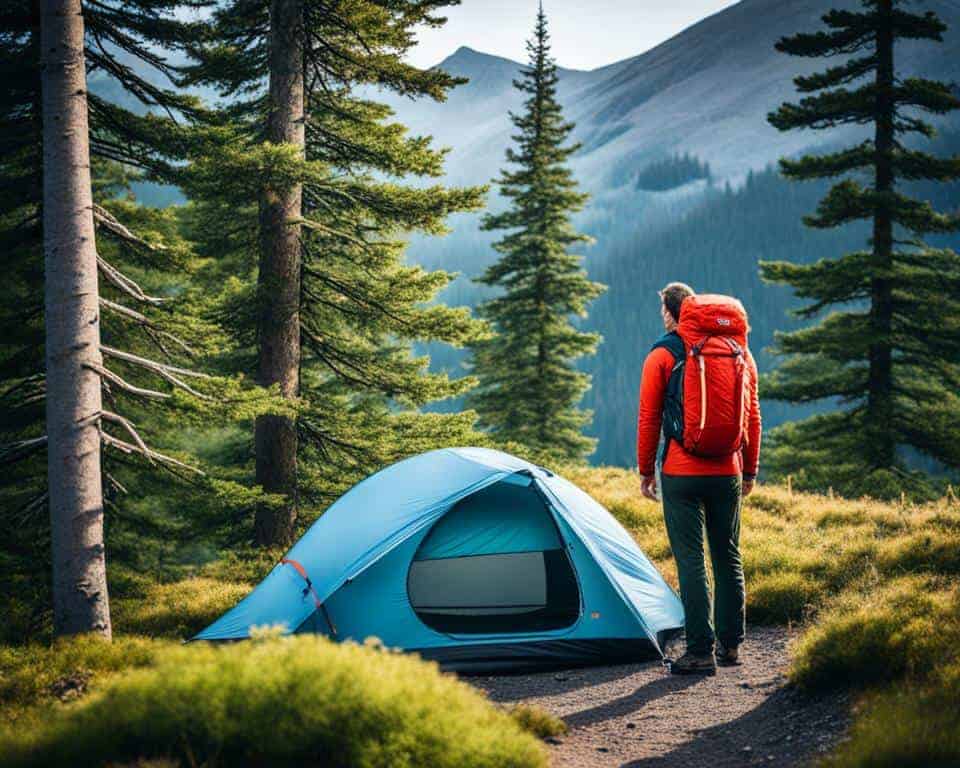
For avid trekkers and outdoor enthusiasts, the integration of lightweight tents and efficient hiking gear is paramount for an enjoyable experience. The burden of a heavy tent can be the difference between a trip to remember and one you’d rather forget. Modern backpacking tents are meticulously designed to minimize weight without compromising on durability and protection from the elements.
Carrying a tent that merges feather-like weight with function allows hikers to venture further and faster, offering a freer form of exploration. However, selecting the ideal lightweight tent involves considering a variety of factors that contribute to its overall portability and suitability to your specific trekking needs.
- Material composition and its impact on weight
- Structural design efficiency and ease of assembly
- Size-to-weight ratio tailored to the number of occupants
- Trade-offs between minimal weight and desired comfort features
As the outdoor market continues to innovate, here are some real-world examples of lightweight tents that have become staples for backcountry explorers:
| Brand | Model | Weight | Capacity | Packed Size |
|---|---|---|---|---|
| Big Agnes | Fly Creek HV UL2 | 2 lbs 4 oz | 2-person | 4″ x 19″ |
| MSR | Hubba Hubba NX | 3 lbs 8 oz | 2-person | 6″ x 18″ |
| NEMO | Hornet Elite | 2 lbs 1 oz | 2-person | 4.5″ x 19.5″ |
A deeper exploration into the tent’s architecture reveals a common theme: the balance between the minimalist approach and providing essential shelter. Ultralight materials such as ripstop nylon and carbon fiber poles are commonly employed, emphasizing the industry’s progression toward backpacking tents that promise to be both extremely lightweight and exceptionally robust.
Durability and Maintenance: Ensuring Your Tent Lasts
When venturing into the great outdoors, your shelter is your sanctuary. It’s not just about having a place to sleep—it’s about ensuring your shelter stands the test of time and the rigors of nature. To achieve maximum tent longevity, focusing on durable camping gear is paramount. Doing so means paying close attention to quality materials and construction techniques, as well as adopting diligent tent maintenance practices.
Quality Materials and Construction Techniques
Imagine a tent as a fortress. Its resilience during howling winds, torrential rains, and the wear-and-tear of constant use, is significantly influenced by its build quality. Brands renowned for their durable camping gear often employ ripstop fabrics, reinforced seams, and robust poles. These materials resist punctures, tears, and breakage, ensuring long-term survivability in diverse conditions. High-denier fabrics, which denote a thicker thread, also play a crucial role in enhancing tent longevity.
Proper Tent Care and Storage Methods
To keep your tent in peak condition, proper care and upkeep are essential. Simple actions post-trip play a significant role in extending your tent’s life. Here are some best practices:
- Clean the tent after each trip, gently removing dirt and debris.
- Avoid packing the tent away when damp to prevent mildew and fabric decay.
- Store in a cool, dry place out of direct sunlight to avoid UV damage.
- Perform regular inspections for any signs of wear and address repairs immediately.
- Use footprint tarps to shield the tent floor from abrasive ground surfaces.
Through attentive care and proper storage, you ensure that your tent remains a trusted companion throughout countless adventures, truly maximizing your investment in durable camping gear.
Setting Up Your Tent: Tips for Beginners and Pros
Mastering the art of tent setup is an essential skill for any outdoor enthusiast. With the right camping tips and knowledge of easy tent assembly, you can streamline your process to maximize relaxation time in the great outdoors. Here are expert strategies to ensure your tent setup is as seamless as possible.
Begin by selecting a flat, elevated area free from rocks and twigs that could damage your tent’s floor. Verify the site’s drainage properties to avoid water accumulation during unexpected rainstorms. Once the perfect spot is chosen, lay out your tent components, so everything is within reach.
- Unfold the tent and locate its corners.
- Assemble your tent poles by snapping together the sections.
- Insert the poles into the corresponding flaps or loops on the tent fabric.
- Raise the structure by securing the ends of the poles into the tent’s corners.
- Clip any additional supports in place to add structural integrity.
- Throw over the rainfly, securing it at multiple points to ensure weather resistance.
Properly staking your tent is paramount to withstand wind and provide stability. Using
“every stake point provided by your tent manufacturer ensures a taut and secure setup that can endure the elements,”
reminds seasoned campers.
- Angle tent stakes away from the tent to enhance grip in the soil.
- Attach guy lines for extra support, particularly useful in windy conditions.
- Utilize nearby natural features such as boulders or trees for additional guy line anchorage points.
With these straightforward steps, both beginners and pros can enjoy fast and dependable tent assembly, allowing more time for adventure and relaxation on their next camping trip.
Safety Considerations: Tents as Shelter in the Wilderness
When venturing into the great outdoors, the sanctuary of your tent becomes a bastion of nighttime safety. It’s that crucial barrier which separates you from the unpredictability of nature. Let’s delve into how your tent can serve as a reliable fortress against the wilderness elements, including uninvited wildlife and adverse weather conditions.

Tents Against Wildlife and Insects
One of the primary concerns for campers is maintaining a wildlife-proof haven. Insect-proof camping tents offer a peaceful night’s sleep, free from interruptions by buzzing mosquitoes or curious critters. The essential features that contribute to wildlife protection in camping tents include fine mesh screens, sturdy zippers, and durable fabric walls. These elements help to secure your slumber zone from the tiny intruders that thrive in natural habitats.
Weather-Proofing Your Tent for Unexpected Scenarios
Weather safety is another cornerstone of any outdoor adventure, and deploying a robust, weather-resistant tent is key. Weather-proofing encompasses various tent aspects such as water-resistant coatings, secure anchor points, and reinforced seams. Tents designed for adverse conditions are equipped to handle anything from sudden summer storms to brisk winter gales, ensuring your outdoor expedition doesn’t turn into an ordeal.
- Use a footprint or tarp beneath your tent to minimize wear and enhance water resistance from the ground.
- Invest in a weather-appropriate rainfly that covers the tent fully and extends over the doorway.
- Secure your tent with high-quality stakes and guy lines for added stability against strong winds.
| Feature | Insect Protection | Weather Durability |
|---|---|---|
| Fabric Material | Tightly-woven, breathable fabrics | Ripstop fabrics with UV resistance |
| Mesh | No-see-um mesh for smaller insects | Dense mesh to reduce debris entry during storms |
| Seams and Zippers | Sealed seams and zippers to prevent entry | Double-stitched, waterproof seams |
A prepared camper is a content camper. Mind the details that fortify your camp against the myriad of outdoor variables, and sleep soundly knowing your shelter is secure.
Comfort and Convenience: Amenities in Modern Tents
Today’s camping enthusiasts expect more than just a simple shelter; they seek a haven that merges the essence of home comfort with the allure of the great outdoors. This evolution of expectations has given rise to ergonomic camping tents equipped with features that offer unprecedented convenience and comfort. Let’s delve into the specifics that transform a regular tent into a luxurious outdoor abode.
Spaciousness and Ergonomic Design
The latest tent amenities are designed keeping in mind the spatial dynamics and the natural movements of the human body, enabling a more comfortable and intuitive camping experience. Ergonomic design is fundamental in modern tent technology, providing campers with ease of movement and functionality. From vestibules to organize gear to roomy sleeping quarters that can accommodate plush air mattresses, the new era of camping tents is all about maximizing space without compromising on portability.
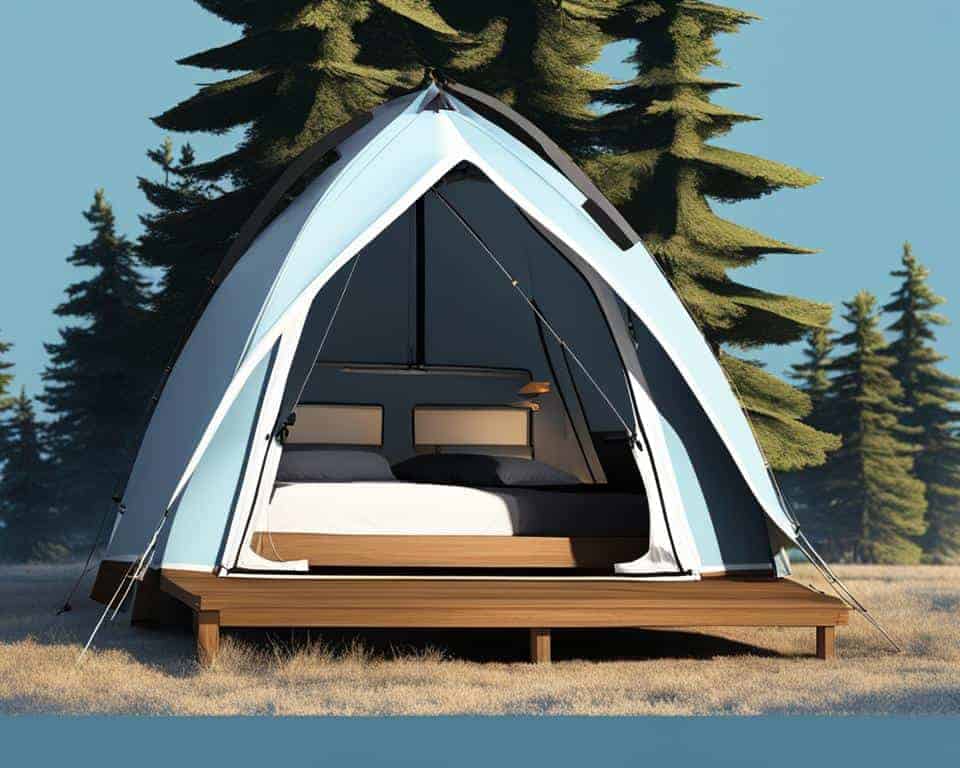
Advanced Features: Built-in Lighting and Electrical Access
As we plunge deeper into the age of technology, modern tents have adapted to include features that were once thought impossible to have in the wilderness. Built-in lighting systems negate the need for handheld torches or headlamps, casting a soft glow as the night settles around the campsite. Further enhancing convenience, tents now come with electrical access points, allowing adventurers to charge devices and keep them within arm’s reach—perfect for capturing those early morning vistas without the hassle of searching for power banks.
| Amenity | Description | Benefits |
|---|---|---|
| Integrated Storage | Compartments and pockets seamlessly designed within the tent’s fabric. | Efficient organization of gear and personal items; clutter-free space. |
| Blackout Fabric | Material that blocks out daylight for a restful sleep experience. | Allows campers to sleep in and control light exposure inside the tent. |
| Weather-Resistant Materials | Fabrics designed to withstand diverse climate challenges. | Protection from the elements and enhanced durability of the tent. |
| Modular Designs | Flexible structure that can be expanded or reduced in size. | Allows for customization based on the number of campers and trip duration. |
These elements, reflective of how far modern tent technology has come, not only instill a sense of amazement but also stress the meticulous thought invested in enhancing our connection with nature. It’s clear that the contemporary tent is no longer just a shelter; it’s a sophisticated retreat that gratifies our need for ease and relaxation when venturing into the wild.
Design Matters: How Tent Architecture Can Enhance Your Trip
The convergence of tent design with user experience has led to the rise of innovative camping shelters that prioritize outdoor living without compromising on style or function. Gone are the days when a tent was merely a utilitarian enclosure used for camping out in the wilderness; today’s designs are as varied and sophisticated as the needs of the campers who use them.
Smart architecture in tent design does more than stand against the elements—it facilitates a deeper connection with the outdoors. By harnessing creativity and technology, manufacturers have crafted structures that enhance livability, improve privacy, and provide ample storage, all while encouraging harmony with the natural environment.
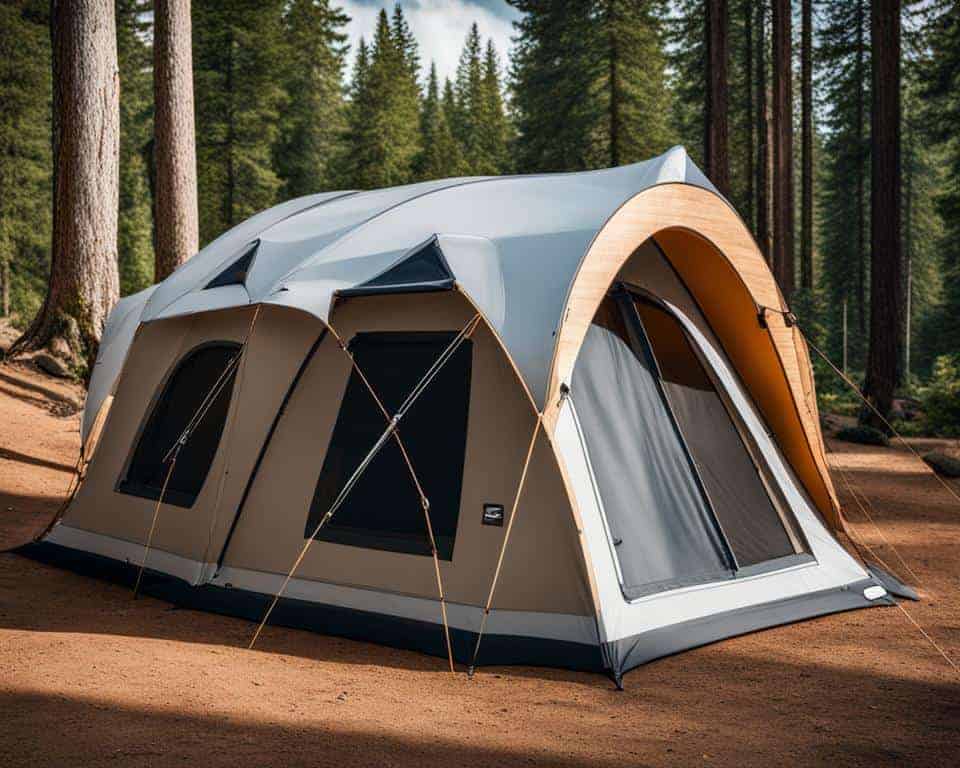
It’s intriguing to consider how these designs translate into real-world comfort and convenience. To illustrate, let’s delve into the characteristics of these pioneering designs:
- The integration of built-in storage options to keep gear organized and accessible.
- Privacy-centric features such as soundproofing materials and separate sleeping quarters.
- Adjustable ventilation systems that allow for a customizable climate within your shelter.
- Multipurpose structures that can transition from full enclosure to airy canopy with ease.
But innovation isn’t limited to the tents’ features alone; the very fabrics and materials used in innovative camping shelters have seen advancements. Weather-resistant coatings, breathable yet insulating materials, and even eco-friendly fabrics are now at the forefront of modern tent construction.
Let’s compare some of the latest tent designs that have redefined what it means to live outdoors:
| Feature | Benefit | Applied Technology |
|---|---|---|
| Geodesic Design | Stability in high-wind conditions | Cross-bracing poles and robust anchors |
| Modular Interiors | Customizable living spaces | Removable walls and adjustable dividers |
| Eco-Friendly Materials | Reduced environmental impact | Recycled fabrics and renewable resources |
| Solar-Powered Elements | Energy efficiency and self-sufficiency | Integrated photovoltaic cells and LED lighting |
Tents have become more than shelters; they are now sophisticated retreats that embody the essence of outdoor living. With the continuously evolving landscape of tent architecture, the experience of engaging with the natural world is ever more luxurious and eco-conscious.
Innovations in tent design play a pivotal role in shaping the future of camping. As we embrace these innovative camping shelters, we step closer to a camping paradigm where comfort meets adventure on an unprecedented level, truly enhancing our journey into the wonders of the great outdoors.
Family Camping Trips: Picking a Tent for Group Dynamics
Gathering around the fire, sharing stories, and sleeping under the stars—group camping trips create lasting memories. But before the adventure begins, it’s crucial to choose the right family camping tent to accommodate everyone’s needs. In this section, we explore the pros and cons of selecting large, multi-room shelters versus multiple smaller tents for group camping.
Big Tents vs. Multiple Smaller Tents
Deciding between a single large tent or multiple smaller tents often comes down to the nature of the group. Large tents offer the convenience of gathering everyone in one place, which is great for families with children who require supervision. Smaller tents provide more privacy and flexibility to spread out, which may be preferred by groups of friends or families with teenagers.
Privacy and Common Areas in Multi-Room Tents
Multi-room family camping tents have revolutionized group camping by offering private sleeping quarters alongside communal living spaces. Such designs allow for nighttime privacy while inviting the group to socialize in a central area during the day, bringing the best of both worlds to the outdoor experience.
| Factors to Consider | Large Family Tent | Multiple Smaller Tents |
|---|---|---|
| Privacy | Private rooms within the same shelter | Complete privacy in separate tents |
| Communal Space | Included and easy to access | Not included, can set up a separate canopy or area |
| Set-Up Difficulty | Generally more complex and time-consuming | Simpler and faster per tent, but more overall set-up |
| Cost | Higher initial investment | Can be cost-efficient, especially if splitting cost |
| Portability | Heavier and bulkier | Lighter and more distributed carrying weight |
Ultimately, whether you’re considering a large, airy palace or several cozy nooks, remember that the best multi-room shelters or family camping tents will cater to your group’s specific preferences and enhance your overall camping experience together.
Eco-Friendly Tents and Sustainable Camping Practices
As the call for sustainability grows louder, outdoor enthusiasts are turning their attention to eco-friendly camping options and practices that help preserve our natural playgrounds. Choices like sustainable gear and green camping solutions not only reduce our ecological footprint but also ensure that the beauty of the outdoors can be enjoyed by future generations. In this spirit, we explore the benefits of eco-friendly tents and how campers can engage in sustainable camping practices.
In practice, sustainable camping means choosing products made from renewable resources, employing eco-conscious manufacturing processes, and supporting brands that are committed to environmental stewardship. From tents created with recycled materials to gear that minimizes waste, every choice counts. Below, we’ll share a guide to choosing eco-friendly camping gear that aligns with your values.
| Eco-Friendly Feature | Benefits | Examples of Green Brands |
|---|---|---|
| Recycled Materials | Reduces waste and consumption of new resources | Big Agnes, Marmot |
| Non-toxic, PFC-free Coatings | Decreases harmful environmental impact | REI Co-op, Patagonia |
| Solar Power Compatibility | Utilizes renewable energy for camping needs | Goal Zero, BioLite |
| Durability and Repairability | Extends product lifespan and reduces need for replacements | MSR, Osprey |
To further your commitment to the environment while enjoying the serenity of nature, consider these sustainable camping practices:
- Practice Leave No Trace principles, ensuring you minimize impact on the natural environment
- Choose a campsite that requires minimal alteration, protecting local flora and fauna
- Reduce waste by packing reusable containers and avoiding single-use plastics
- Engage in proper waste disposal and recycling whenever possible
Adopting eco-friendly camping habits isn’t just about the gear we use, it’s also about our actions in the outdoors. By incorporating these sustainable gear choices and green camping solutions, campers can take meaningful steps towards preserving our pristine natural areas for the long haul.
The Importance of Proper Camping Tents
Throughout this exploration of essential camping equipment, one factor reigns supreme – the critical necessity for a proper camping tent. A shelter in the wilderness acts as your bastion of safety, your haven of comfort, and your liaison with nature. As we’ve dissected the variables that contribute to a successful camping experience, it is clear that a tent is more than a mere item on your checklist; it is the heartbeat of your outdoor adventure essentials.
When considering the varied environmental conditions one may encounter, the tent emerges as a versatile companion – guarding against strenuous weather, repelling unwelcome insects, and providing a cozy nidus for rest and recuperation. These aspects are not to be taken lightly, for they collectively buffer adventurers from the erratic behavior of the great outdoors.
- Protection from the Elements: Ensuring safety from weather and environmental challenges.
- Comfort After Activities: Providing a place to rest and rejuvenate for prolonged adventures.
- Connection with Environment: Fostering a harmonious balance between human presence and natural settings.
To choose a tent is to recognize its value as the architect of a memorable encampment. Conclusively, a tent represents a sacred space amidst the grandeur of nature, a pivotal component designed not only to enhance survival but to augment the joy of outdoor adventure. Veteran explorers and novice campers alike understand that skimping on a reliable tent could diminish the essence of their experience; thus, investing in the right tent is an investment in the overall quality of their outdoor escapades.
As the sun dips below the horizon, casting an amber glow on the day’s end, we settle within our chosen shelters, a testament to our respect for the natural world and commitment to our comfort and protection. The echo through the canyons, the whisper of the forest leaves, and the serenity of the open skies remind us of the irreplaceable role that proper camping tents play in the realm of exploration. And so, equipped with this wisdom, we venture forth, secure in our understanding that our tent is indeed one of the most essential pieces of camping equipment we’ll carry on our journey into the heart of the wilderness.
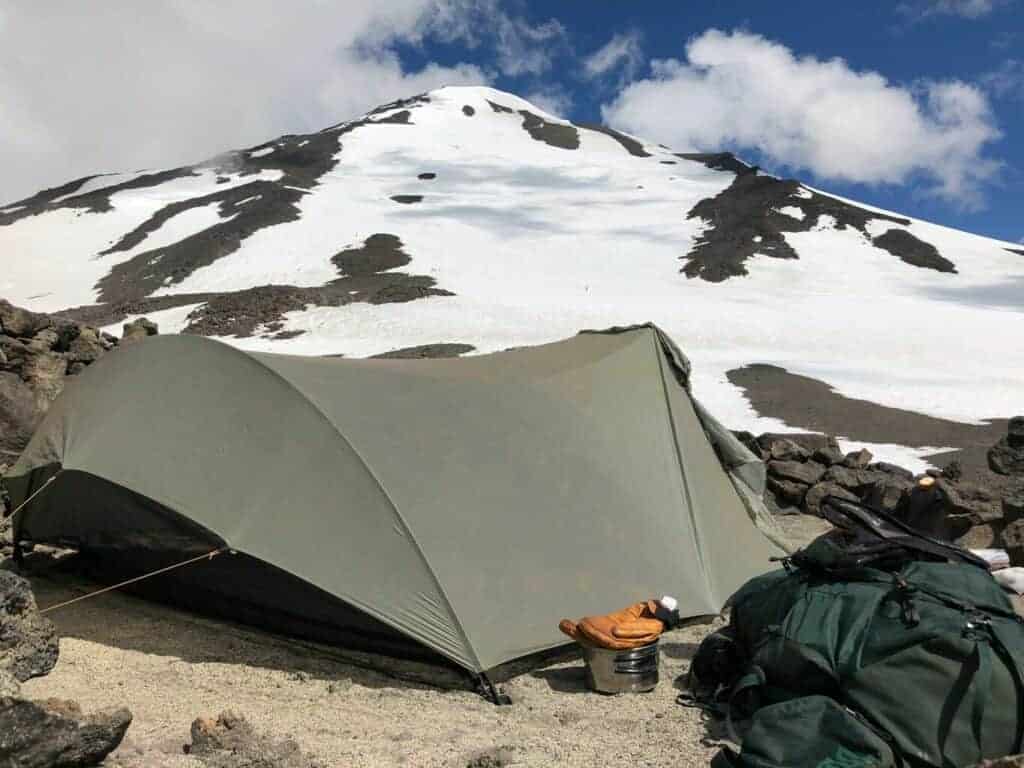
Conclusion
Embarking on outdoor adventures calls for not just a sense of exploration but also a need for a dependable haven against the variabilities of nature. Throughout this article, we’ve underscored the pivotal role that proper camping tents play in enriching your outdoor experiences. From standing resilient against diverse weather conditions and providing a lightweight companion on your hiking trails to offering the comforts and conveniences that modern campers desire, the right tent is undeniably at the heart of a captivating outdoor narrative.
The selection of a camping shelter is a decision that goes beyond mere aesthetics, engaging a deeper awareness of weather compatibility, space requirements, and sustainable practices. With insights into the various aspects of tent architecture, features, and design, we’ve illuminated the path to choosing tents that are not only shelters but also homes in the wilderness, echoing the rhythms of your adventures and the essence of your outdoor spirit.
Before setting foot into the vast wonder that is our natural world, I invite you to pause and consider the sanctuary that will define your resting silhouettes against the night sky. Invest in a camping tent that aligns with your values, meets your needs, and stands as a steadfast partner in your journey of discovery. May your future outdoor expeditions be safe, comfortable, and brimming with the joy of living amidst the raw elegance of nature.
FAQ
What makes a camping tent suitable for outdoor adventures?
A suitable camping tent is one that provides reliable shelter, offers durability against the elements, and enhances your camping experience with comfort. It should be made of weather-resistant materials and offer features suitable to the environment you’ll be exploring.
How do I choose a tent based on different weather conditions?
Assess your camping environment to determine if you need a 3-season tent for moderate conditions or a 4-season tent for harsher weather. Look for weather-resistant camping tents with features like wind resistance and ventilation technology to match the predicted weather patterns.
Why is tent weight and size important for hiking?
Tent weight and size directly affect your hiking gear’s portability and your comfort on the trail. Lightweight tents, especially backpacking tents, are designed for ease of carrying, which is essential for long-distance hikes and for reducing overall fatigue.
How can I ensure my camping tent lasts for many trips?
Select a tent with quality materials and construction techniques to ensure durability. Practice proper tent maintenance by cleaning it after use, ensuring it is completely dry before storage, and storing it in a cool, dry place to maintain its condition.
What are the top tips for setting up a tent efficiently?
Begin by choosing a level campsite clear of debris. Lay out all the components, and follow the instructions for assembling the tent poles and attaching the fabric. Ensure the tent is properly secured with stakes and guy lines. Practice setting up your tent before your trip for a smoother experience.
How do tents protect against wildlife and insects during camping trips?
Tents with fine mesh netting can offer protection against insects, while sturdy zippers and solid fabric panels can help deter curious wildlife. Furthermore, insect-proof camping tents that incorporate certain materials and design elements can provide an added layer of safety.
What amenities are available in modern tents for added comfort and convenience?
Modern ergonomic camping tents may come with amenities like built-in lighting, electrical access ports for powering devices, storage pockets, and gear lofts. Some even have vestibules for extra storage or awnings for shade, enhancing your outdoor living experience.
How does the design of a tent impact my camping experience?
The architectural design of a tent can influence airflow, temperature control, interior space, privacy, and integration with the surrounding environment. Innovative camping shelters often incorporate features that maximize livability and convenience.
What should I consider when selecting a tent for family or group camping?
For family or group camping, consider the size and layout of the tent. Decide between one large tent or multiple smaller ones based on your need for space and privacy. Multi-room shelters with designated sleeping and communal areas can be beneficial for group dynamics.
How can I camp more sustainably with eco-friendly tents?
Choose tents made from sustainable or recycled materials and follow green camping solutions such as minimizing waste, leaving no trace, and supporting eco-friendly camping brands. Eco-conscious camping gear helps reduce your environmental footprint while enjoying the great outdoors.
Why is investing in a proper camping tent essential for outdoor adventures?
Investing in the right tent is essential for safety, protection from weather, and to enhance your comfort in the wilderness. A proper tent serves as your base of operations and a refuge in nature, making it a critical piece of essential camping equipment for a successful adventure.

































